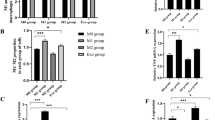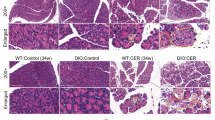Abstract
Background and Aims
Obesity is an important risk factor for severe acute pancreatitis. The necrosis of epididymal adipose tissue occurs in severe acute pancreatitis. Adipose tissue macrophages play an important role in metabolic related inflammation. Therefore, we explored the potential mechanisms between adipose tissue macrophages and obesity-related severe acute pancreatitis.
Methods
Severe acute pancreatitis mice model was induced by caerulein with lipopolysaccharide. The severity of severe acute pancreatitis was evaluated according to the morphological, general, and biochemical change. We assessed the injury of epididymal white adipose tissue, pancreas, and adipose tissue macrophages in obese mice and lean mice with severe acute pancreatitis. Outcomes of caerulein-induced severe acute pancreatitis were studied in lean and obese mice with or without lipase inhibitor orlistat.
Results
Fat necrosis and pancreatic injury increased in the SAP groups. High levels of serum free fatty acid and triglyceride were increased significantly in the SAP group. The NLRP3-caspase1 inflammasome signal pathway in adipose tissue macrophages markedly enhanced in the SAP groups compared with control group. Free fatty acid can trigger macrophages inflammation through NLRP3-caspase1. Lipase inhibited by orlistat remarkably decreased in adipose tissue necrosis, and the levels of serum lipase, amylase, and pancreatic tissue damage decreased in the orlistat group compared with the SAP group. The NLRP3-caspase1 inflammasome pathway in adipose tissue macrophages markedly decreased in the orlistat groups compared with SAP group. The levels of serum free fatty acid and triglyceride were decreased significantly in the orlistat group.
Conclusions
Inflammation increases in adipose tissue macrophages of obese mice with severe acute pancreatitis. Free fatty acid generated via adipocyte lipolysis worsens inflammation in adipose tissue macrophages and the outcome of severe acute pancreatitis in obese mice through the NLRP3-caspase1 inflammasome pathway.






Similar content being viewed by others
References
Ogawa M. Acute pancreatitis and cytokines: “second attack” by septic complication leads to organ failure. Pancreas 1998;16:312–315.
Garg PK, Singh VP. Organ failure due to systemic injury in acute pancreatitis. Gastroenterology 2019;156:2008–2023.
Khatua B, El-Kurdi B, Singh VP. Obesity and pancreatitis. Curr Opin Gastroenterol 2017;33:374–382.
Segersvärd R, Sylván M, Herrington M, Larsson J, Permert J. Obesity increases the severity of acute experimental pancreatitis in the rat. Scand J Gastroenterol 2001;36:658–663.
Martínez J, Johnson CD, Sánchez-Payá J, de Madaria E, Robles-Díaz G, Pérez-Mateo M. Obesity is a definitive risk factor of severity and mortality in acute pancreatitis: an updated meta-analysis. Pancreatology 2006;6:206–209.
Chen SM, Xiong GS, Wu SM. Is obesity an indicator of complications and mortality in acute pancreatitis? An updated meta-analysis. J Dig Dis 2012;13:244–251. https://doi.org/10.1111/j.1751-2980.2012.00587.x.
Acharya C, Navina S, Singh VP. Role of pancreatic fat in the outcomes of pancreatitis. Pancreatology 2014;14:403–408.
Wang SQ, Li SJ, Feng QX, Feng XY, Xu L, Zhao QC. Overweight is an additional prognostic factor in acute pancreatitis: a meta-analysis. Pancreatology 2011;11:92–98.
Patel K, Trivedi RN, Durgampudi C, et al. Lipolysis of visceral adipocyte triglyceride by pancreatic lipases converts mild acute pancreatitis to severe pancreatitis independent of necrosis and inflammation. Am J Pathol 2015;185:808–819.
Navina S, Acharya C, DeLany JP, et al. Lipotoxicity causes multisystem organ failure and exacerbates acute pancreatitis in obesity. Sci Transl Med 2011;3:107–110.
Pereda J, Pérez S, Escobar J, et al. Obese rats exhibit high levels of fat necrosis and isoprostanes in taurocholate-induced acute pancreatitis. PLoS One 2012;7:e44383.
Thomas D, Apovian C. Macrophage functions in lean and obese adipose tissue. Metabolism 2017;72:120–143.
Russo L, Lumeng CN. Properties and functions of adipose tissue macrophages in obesity. Immunology 2018;155:407–417.
Shrivastava P, Bhatia M. Essential role of monocytes and macrophages in the progression of acute pancreatitis. World J Gastroenterol 2010;16:3995–4002.
Tsuang W, Navaneethan U, Ruiz L, Palascak JB, Gelrud A. Hypertriglyceridemic pancreatitis: presentation and management. Am J Gastroenterol 2009;104:984–991.
Schmidt J, Rattner DW, Lewandrowski K, et al. A better model of acute pancreatitis for evaluating therapy. Ann Surg 1992;215:44–56.
Lumeng CN, Bodzin JL, Saltiel AR. Obesity induces a phenotypic switch in adipose tissue macrophage polarization. J Clin Invest 2007;117:175–184.
Mentula P, Kylänpää ML, Kemppainen E, Puolakkainen P. Obesity correlates with early hyperglycemia in patients with acute pancreatitis who developed organ failure. Pancreas 2008;36:e21-25.
Zhou D, Huang C, Lin Z, et al. Macrophage polarization and function with emphasis on the evolving roles of coordinated regulation of cellular signaling pathways. Cell Signal 2014;26:192–197.
Caslin HL, Bhanot M, Bolus WR. Adipose tissue macrophages: unique polarization and bioenergetics in obesity. 2020;295:101–113.
Franco-Pons N, Gea-Sorlí S, Closa D. Release of inflammatory mediators by adipose tissue during acute pancreatitis. J Pathol 2010;221:175–182.
Coppack SW. Pro-inflammatory cytokines and adipose tissue. Proc Nutr Soc 2001;60:349–356.
Xu X, Grijalva A, Skowronski A, van Eijk M, Serlie MJ, Ferrante AW Jr. Obesity activates a program of lysosomal-dependent lipid metabolism in adipose tissue macrophages independently of classic activation. Cell Metab 2013;18:816–830.
Kratz M, Coats BR, Hisert KB, et al. Metabolic dysfunction drives a mechanistically distinct proinflammatory phenotype in adipose tissue macrophages. Cell Metab 2014;20:614–625.
de Oliveira C, Khatua B, Noel P, et al. Pancreatic triglyceride lipase mediates lipotoxic systemic inflammation. J Clin Invest 2020;130:1931–1947.
Bonjoch L, Gea-Sorlí S, Closa D. Lipids generated during acute pancreatitis increase inflammatory status of macrophages by interfering with their M2 polarization. Pancreatology 2015;15:352–359.
Jiao P, Ma J, Feng B, et al. FFA-induced adipocyte inflammation and insulin resistance: involvement of ER stress and IKKβ pathways. Obesity (Silver Spring) 2011;19:483–491.
Ahmad R, Al-Roub A, Kochumon S, et al. The synergy between palmitate and TNF-α for CCL2 production is dependent on the TRIF/IRF3 pathway: implications for metabolic inflammation. J Immunol 2018;200:3599–3611.
Xing JH, Li R, Gao YQ, et al. NLRP3 inflammasome mediate palmitate-induced endothelial dysfunction. Life Sci 2019;239:116882.
Shao BZ, Xu ZQ, Han BZ, Su DF, Liu C. NLRP3 inflammasome and its inhibitors: a review. Front Pharmacol 2015;6:262.
Mangan MSJ, Olhava EJ, Roush WR, Seidel HM, Glick GD, Latz E. Targeting the NLRP3 inflammasome in inflammatory diseases. Nat Rev Drug Discov 2018;17:588–606.
Ralston JC, Lyons CL, Kennedy EB, Kirwan AM, Roche HM. Fatty acids and NLRP3 inflammasome-mediated inflammation in metabolic tissues. Annu Rev Nutr 2017;37:77–102.
Vandanmagsar B, Youm YH, Ravussin A, et al. The NLRP3 inflammasome instigates obesity-induced inflammation and insulin resistance. Nat Med 2011;17:179–188.
Esser N, Legrand-Poels S, Piette J, Scheen AJ, Paquot N. Inflammation as a link between obesity, metabolic syndrome and type 2 diabetes. Diabetes Res Clin Pract 2014;105:141–150.
Qi Y, Du X, Yao X, Zhao Y. Vildagliptin inhibits high free fatty acid (FFA)-induced NLRP3 inflammasome activation in endothelial cells. Artif Cells Nanomed Biotechnol 2019;47:1067–1074.
Nagakannan P, Islam MI, Conrad M, Eftekharpour E. Cathepsin B is an executioner of ferroptosis. Biochim Biophys Acta Mol Cell Res 2021;1868:118928.
Gammelsrud A, Solhaug A, Dendelé B, et al. Enniatin B-induced cell death and inflammatory responses in RAW 267.4 murine macrophages. Toxicol Appl Pharmacol 2012;261:74–87.
Hoseini Z, Sepahvand F, Rashidi B, Sahebkar A, Masoudifar A, Mirzaei H. NLRP3 inflammasome: Its regulation and involvement in atherosclerosis. J Cell Physiol 2018;233:2116–2132.
Acknowledgments
This study was supported by the National Natural Science Foundation of China (Nos. 81770637).
Author information
Authors and Affiliations
Corresponding author
Ethics declarations
Conflict of interest
All authors state that they have no conflict of interest.
Additional information
Publisher's Note
Springer Nature remains neutral with regard to jurisdictional claims in published maps and institutional affiliations.
Rights and permissions
About this article
Cite this article
Xu, T., Sheng, L., Guo, X. et al. Free Fatty Acid Increases the Expression of NLRP3-Caspase1 in Adipose Tissue Macrophages in Obese Severe Acute Pancreatitis. Dig Dis Sci 67, 2220–2231 (2022). https://doi.org/10.1007/s10620-021-07027-w
Received:
Accepted:
Published:
Issue Date:
DOI: https://doi.org/10.1007/s10620-021-07027-w




